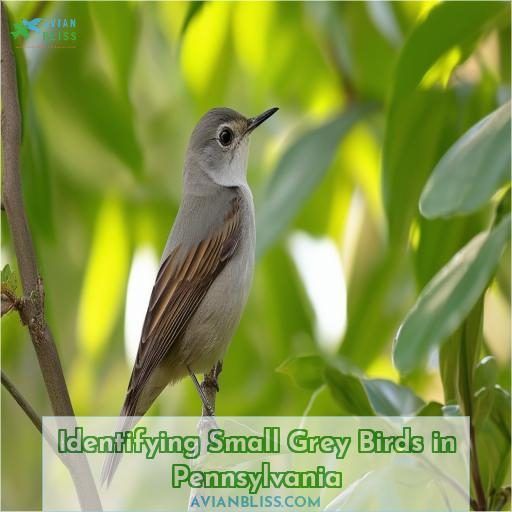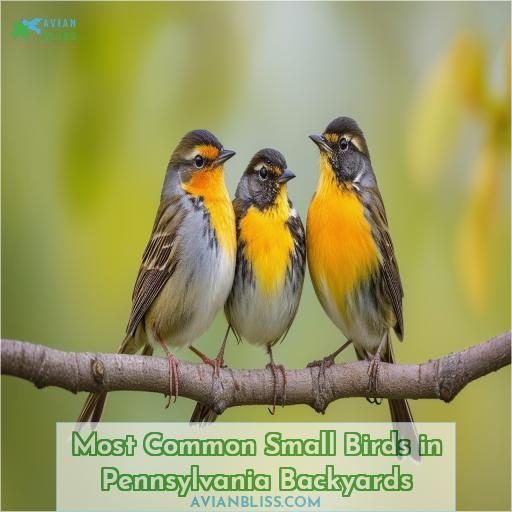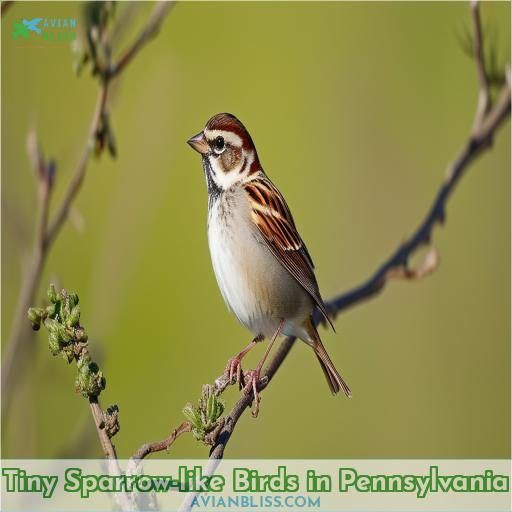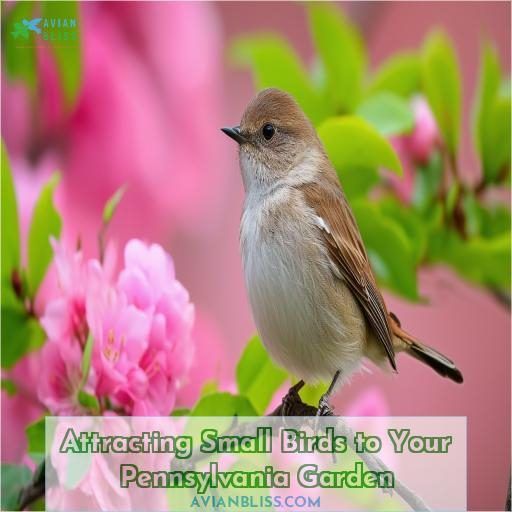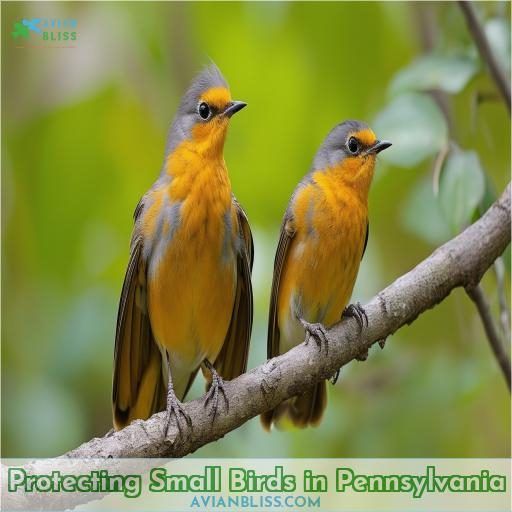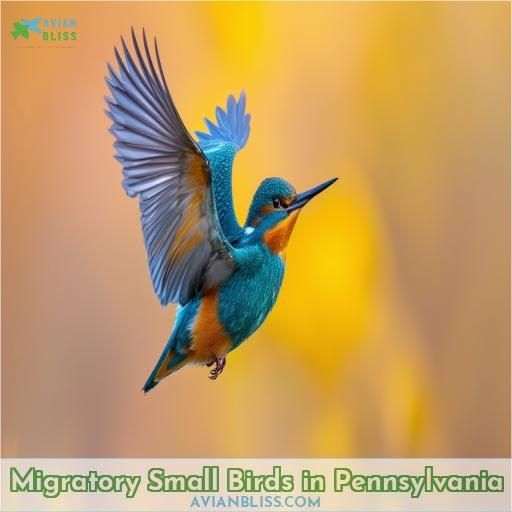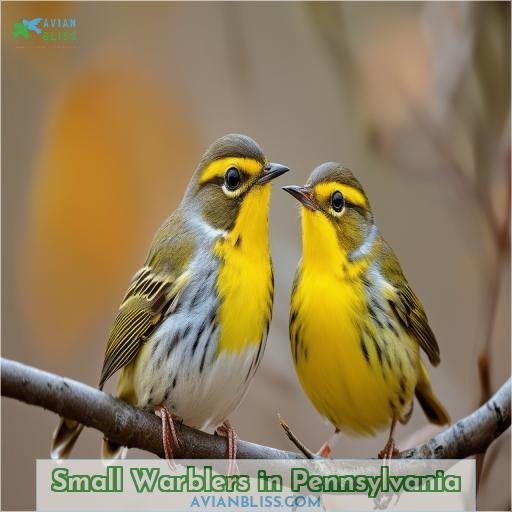This site is supported by our readers. We may earn a commission, at no cost to you, if you purchase through links.
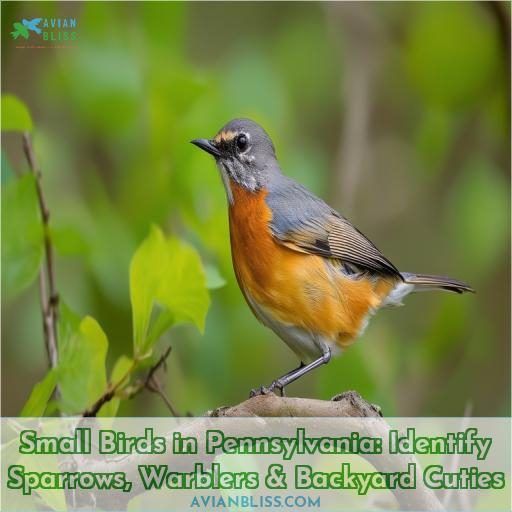
Spot the tufted titmouse’s perky crest, the white-breasted nuthatch’s acrobatic antics, and the chipping sparrow’s rusty crown.
Don’t overlook those backyard regulars – the feisty house finch and dazzling American goldfinch.
With keen observation skills and knowledge of feather patterns, beak shapes, and behaviors, you’ll soon master identifying these feathered cuties. But that’s just the beginning; there’s so much more to discover about Pennsylvania’s small bird wonders.
Table Of Contents
- Key Takeaways
- Identifying Small Grey Birds in Pennsylvania
- Most Common Small Birds in Pennsylvania Backyards
- Tiny Sparrow-like Birds in Pennsylvania
- Identifying Baby Birds in Pennsylvania
- Attracting Small Birds to Your Pennsylvania Garden
- Protecting Small Birds in Pennsylvania
- Migratory Small Birds in Pennsylvania
- Small Woodpeckers in Pennsylvania
- Small Warblers in Pennsylvania
- Rare Small Birds in Pennsylvania
- Frequently Asked Questions (FAQs)
- What are the little GREY birds in Pennsylvania?
- What is the most common bird in Pennsylvania?
- What bird looks like a tiny sparrow?
- How to identify baby birds?
- What are the best bird feeders for small birds?
- How do I prevent window strikes for small birds?
- What nesting boxes are suitable for small bird species?
- Are there any small bird species of conservation concern?
- Conclusion
Key Takeaways
- "The journey of a thousand miles begins with a single step" – take yours by savoring the delightful symphony of small birds flitting in your Pennsylvania backyard. From vibrant warblers to cheeky chickadees, these feathered cuties will steal your heart!
- Creating an inviting avian oasis is easier than you’d think. Roll out the red carpet with native plants, brush piles for shelter, and a well-stocked buffet of feeders. These tiny troubadours will flock to your nature-loving abode in no time.
- Keep those eagle eyes peeled for wee woodland wonders like ruby-crowned kinglets, pint-sized dynamos darting through the trees like feathered acrobats. Spotting rarities like the golden-winged warbler is like finding a sparkling gem on a nature trail!
- Protecting our fledgling friends from window strikes, pesticides, and purr-fect predators ensures their enchanting melodies grace our backyards for generations to come. A little TLC goes a long way in preserving nature’s treasures right outside your door.
Identifying Small Grey Birds in Pennsylvania
You’ll often encounter three small grey birds in Pennsylvania yards and parks:
The tufted titmouse, a perky bird with a grey crest.
The white-breasted nuthatch, recognizable by its nasal "yank-yank" call and habit of walking down tree trunks headfirst.
The Carolina chickadee, a lively bird with a black cap and bib.
Learn their distinctive field marks, calls, and behaviors to identify these delightful neighborhood aviators.
Tufted Titmouse
You’ll often see this perky little gray bird with a jaunty crest hopping around your backyard feeders. Tufted titmice are:
- Lively acrobats, clinging upside down to snag seeds
- Animated vocalists, with a distinctive "peter-peter" call
- Cavity nesters, readily using nest boxes
- Frequent visitors to suet and sunflower seed feeders
- Pugnacious, chasing even larger birds from their territory
Let their energetic presence brighten your day! Offering welcoming habitat nurtures nature connections.
White-breasted Nuthatch
You might spot the white-breasted nuthatch hitching along tree trunks, upside-down or rightside-up. This agile bird’s sturdy beak cracks open seeds and insects hidden in bark crevices. During winter, nuthatches cache conifer seeds and recall their stash locations with remarkable spatial memory. Their nasal "yank yank" calls enliven woodlands year-round.
Carolina Chickadee
As you watch these small gray birds flit from branch to branch, you’ll notice the Carolina chickadee’s distinctive black cap and bib.
These lively visitors frequent backyard bird feeders, snatching up sunflower seeds and suet while chirping their signature "chick-a-dee-dee-dee" calls.
Listen closely, and you may hear their familiar whistled songs amidst the chorus of northern cardinals, Carolina wrens, and song sparrows.
Most Common Small Birds in Pennsylvania Backyards
You’re likely familiar with the ubiquitous house sparrow, recognizable by its brown and grey streaked feathers and conical beak, often seen foraging near human habitats. Another common sight in Pennsylvania backyards is the vibrant house finch, with the male’s distinct red head and breast, and the American goldfinch, a small and active yellow bird that frequents feeders.
House Sparrow
You’ve likely seen the ubiquitous house sparrow hopping around your yard, with its:
- Chunky brown body with gray crown
- Black bib and streaked back
- Noisy chirps and aggressive behavior
- Nests built in eaves and cavities
- Fondness for seeds and crumbs
These non-native birds thrive in human environments, making them a common backyard sight.
House Finch
You’ll likely spot house finches at your backyard feeder, happily chirping their cheerful song. These compact birds, with the males’ rosy-red head and breast, frequent suburban areas. They thrive on seeds and often nest in shrubs or hanging plants—keep an eye out for their cozy nests made from twigs and plant fibers.
American Goldfinch
You’ll often spot the vibrant American Goldfinch at your feeder, fluttering its bright yellow body and black cap. These lively birds:
- Migrate south for winter, returning north in spring
- Dine on seeds, particularly thistle and nyjer
- Sing a delightful "po-ta-to-chip" song
Enjoy their cheerful presence in your backyard all summer long.
Tiny Sparrow-like Birds in Pennsylvania
You’ll often spot tiny sparrow-like birds hopping around your Pennsylvania backyard, foraging for seeds and insects. The chipping sparrow, with its rusty crown and black eye line, field sparrow with pinkish bill, and streaky song sparrow frequent open areas like lawns and gardens in the region.
Chipping Sparrow
You’ll often spot the chipping sparrow hopping on the ground, foraging for seeds and insects. Listen for its distinctive trilling song, a rapid series of chips. These tiny sparrows nest in shrubs and build cup-shaped nests lined with hair and grass. Don’t confuse them with house sparrows—chipping sparrows have a reddish cap and black eye line.
Field Sparrow
Another tiny backyard bird you may spot is the field sparrow. Its rusty cap and pink bill make it easy to identify. If you hear a bouncy, accelerating trill, look for:
- A small, streaky brown bird
- Perched on a low branch or shrub
- Foraging on seeds and insects on the ground
Field sparrows prefer open fields with scattered bushes—providing the perfect mix of cover and foraging grounds.
Song Sparrow
While the chipping sparrow occupies open woodlands, keep an eye out for its cousin, the aptly named song sparrow. This dapper bird sports brown streaks on its chest, a brown crown with a gray stripe, and a cheerful song that graces shrubby areas. Offer dried mealworms, nyjer seed, and native shrubs for protection. Here’s a visual guide:
| Feature | Description |
|---|---|
| Plumage | Brown streaks, gray head stripe |
| Food | Insects, seeds, mealworms |
| Habitat | Shrubs, thickets, woodland edges |
| Nest | Well-concealed cup in shrub or brush pile |
| Song | Cheerful, musical trill or series of notes |
Identifying Baby Birds in Pennsylvania
When identifying baby birds in Pennsylvania, pay close attention to their feather patterns and beak shapes. These physical characteristics, along with observing their behavior, will provide important clues to determining the species correctly.
Feather Patterns
When identifying baby birds, pay close attention to their feather patterns. Look for variations in feather types, colors, shapes, and markings – these distinct features often indicate different species. For example, sparrow hatchlings typically have fluffy, brown-streaked down feathers, while warbler nestlings sport smoother, patterned plumage adapted for camouflage.
Beak Shape
Another clue for identifying baby birds is their beak shape. Study the following:
- Thin, pointed beak: Insect-eaters like warblers
- Short, conical beak: Seed-eaters like sparrows
- Long, slender beak: Insect and nectar feeders like hummingbirds
Behavior
You’ll also want to observe their behavior. Look for clues like migratory patterns, courtship rituals, nesting preferences, and feeding strategies. Certain behaviors are distinctive—for example, goldfinches wave their tails while perching. By noting population trends too, you’ll gain a deeper understanding of Pennsylvania’s avian visitors.
Attracting Small Birds to Your Pennsylvania Garden
To attract a variety of small birds to your Pennsylvania garden, provide a reliable source of food like seed feeders, suet cakes, and fresh water in birdbaths or shallow dishes. Creating dense cover with native shrubs and brush piles offers nesting sites and protection from predators, making your outdoor space an inviting sanctuary for these delightful feathered visitors.
Providing Food
Providing a variety of bird feeders and seed mixes is a surefire way to attract small birds. Offer suet cakes, which are high-energy treats perfect for woodpeckers and nuthatches. Plant native plants that provide natural food sources like berries and seeds. By creating an inviting buffet, you’ll soon have a lively backyard full of feathered friends.
Adding Water Sources
You’ll attract more small birds by adding water sources like bird baths or shallow dishes. These provide drinking and bathing spots, enticing them to linger in your yard. Make sure the water is:
- Clean and replaced regularly
- Slightly sloping with pebbles for perching
- Located near cover for safety
- Heated during winter to prevent freezing
Having accessible water is key for these delicate feathered friends to thrive.
Creating Cover
You’ll also want to provide cover for small birds by planting hedges, installing birdhouses, and cultivating dense bushes and trees. Small birds seek out thick vegetation and thickets where they can nest, roost, and hide from predators. Overgrown areas with tangled branches offer ideal nesting spots and protection from the elements.
Protecting Small Birds in Pennsylvania
You can protect small birds in Pennsylvania by taking preventative measures against window collisions, which are a major threat. Keep cats indoors, as they’re skilled predators that can greatly impact bird populations. Additionally, avoid using pesticides on your property, as these chemicals can harm or kill birds directly or contaminate their food sources.
Preventing Window Collisions
You’ve created an inviting environment for small birds, but window collisions pose a risk. 1) Apply window films or decals to make glass visible. 2) Place bird feeders and baths away from windows. 3) Plant native shrubs near windows to deter quick flights. These simple steps minimize collisions, keeping your feathered friends safe.
Keeping Cats Indoors
You can protect small birds by keeping your cats indoors. Outdoor cats are a major threat, killing billions of birds each year. Although hunting is natural behavior, domestic cats are non-native predators that endanger already declining bird populations.
| Safety | Freedom | Belonging |
|---|---|---|
| Keeps birds safe from cat predation | Allows birds to freely forage without fear | Preserves bird communities in your yard |
| Protects baby birds in nests | Gives birds freedom to nest peacefully | Lets birds belong in their natural habitat |
| Prevents window collisions caused by cats | Frees you from worrying about your cat harming birds | Creates a sense of belonging for nature lovers |
Avoiding Pesticides
To protect small birds, avoid using synthetic pesticides in your garden. These chemicals harm insects they depend on, contaminate water sources, and accumulate toxins in birds’ bodies. Instead, explore organic pest control like companion planting, neem oil, and beneficial insects. An eco-friendly approach guarantees your yard remains a safe haven for feathered visitors.
Migratory Small Birds in Pennsylvania
The Eastern Phoebe is a migratory bird that graces Pennsylvania’s landscapes during its seasonal travels. It is a plump, grayish flycatcher with a distinctive tail-bobbing habit. You’ll likely spot it perching on fences or branches near woodland edges and open fields from April through September.
The Ruby-crowned Kinglet is another migratory bird that visits Pennsylvania. It is a tiny, olive-green bird with a striking ruby crown patch. It forages in trees and shrubs during its spring and fall migrations.
Eastern Phoebe
You’ll often spot the Eastern Phoebe during spring migration or summer breeding season. These drab brownish-gray flycatchers perch upright on fences or dead branches, flicking their tails while snatching insects midair. Though populations face habitat loss, providing nest boxes and leaving dead trees can help conserve these delightful migrants.
Ruby-crowned Kinglet
You’ll catch sight of ruby-crowned kinglets zipping through woodlands in spring and fall. These tiny olive-green birds sport a ruby crest, white eye-ring, and yellow edges on their dark wings. Listen for their high-pitched tsee-tsee-tsee song echoing through the trees as they forage for insects among the branches. Attract them to your yard with suet feeders and berry bushes.
Small Woodpeckers in Pennsylvania
You’ll often spot three types of small woodpeckers in Pennsylvania: the downy woodpecker, the hairy woodpecker, and the red-bellied woodpecker. With their distinctive feather patterns, chisel-like bills, and woodpecker behavior of clinging to tree trunks and branches, these feathered friends are a delight to observe in backyards and woodlands across the state.
Downy Woodpecker
You’ll spot the black-and-white Downy Woodpecker, our smallest woodpecker, pecking on tree trunks and visiting bird feeders. This feisty bird nests in cavities it drills in dead wood, feeding on insects under the bark. Listen for its high-pitched "pik" call and whinnying song as it forages in woodlands and suburbs.
Hairy Woodpecker
Looking nearly identical but larger than the Downy, the Hairy Woodpecker boasts a dimorphic plumage with distinct white stripes along its back. Observe their foraging behaviors as they vigorously chisel into decaying wood, preferring mature deciduous trees for nest sites higher off the ground. Their resounding drumming signals their presence throughout woodlands.
Red-bellied Woodpecker
You’ll often spot the Red-bellied Woodpecker in your Pennsylvania backyard, with its distinctive:
- Red belly (despite the name)
- Black-and-white barred back
- Zebra-striped wings
- Bright red crown
This energetic forager hammers on trees, devouring insects and seeds. It nests in cavities, favoring mature woodlands with tall trees. Its loud calls and animated antics enliven any outdoor space.
Small Warblers in Pennsylvania
While exploring Pennsylvania’s diverse habitats, you’ll encounter several small, vibrant warblers during spring and summer.
The Yellow Warbler, with its bright yellow plumage and distinctive "sweet-sweet-sweet" song, often nests in shrubby areas near water.
The Common Yellowthroat, aptly named for its bright yellow throat, prefers dense vegetation like marshes and overgrown fields.
The Pine Warbler, with its olive-yellow coloring, favors pine forests and can often be spotted foraging along tree trunks.
Yellow Warbler
You’ll spot the cheerful yellow warbler flitting among trees and shrubs, singing its sweet, whistled song. This migratory bird breeds across Pennsylvania, arriving in spring and nesting in shrubby areas near water. It weaves an intricate cup nest and munches on insects. Look for its bright yellow plumage, with rusty streaks on the breast. Provide native plants and you may attract these sunny warblers to your garden.
| Appearance | Male: Bright yellow with rusty streaks on breast. Female: Duller yellow. |
|---|---|
| Song | Sweet, whistled notes "sweet-sweet-sweet" and trills |
| Habitat | Shrubby areas near water, woodlands |
| Diet | Insects, some berries and seeds |
Common Yellowthroat
The common yellowthroat, a vivid black-and-yellow warbler, adds its distinctive "witchity-witchity" song to Pennsylvania woodlands. You’ll spot this feisty bird skulking in thickets and marshes, where it forages for:
- Insects
- Spiders
- Berries
- Seeds
Listen for the male’s emphatic calls staking out his territory, and watch for the female’s well-camouflaged nest woven low in dense vegetation.
Pine Warbler
While the common yellowthroat prefers dense vegetation, you might spot pine warblers high in the canopy of pine forests.
These streaky olive birds feed on insects and seeds, nesting in pine tree cavities.
Listen for their trills during spring migration and breeding season.
Though still abundant, pine warbler populations face threats from habitat loss and fragmentation.
Promoting sustainable forestry practices can help conserve this delightful songbird.
Rare Small Birds in Pennsylvania
While in Pennsylvania, keep an eye out for the elusive Henslow’s Sparrow, a small, streaky brown bird that breeds in fields and meadows. You might also spot the dazzling Swainson’s Warbler, a rare, dark olive-brown bird with a distinctive brown crown and supercilium, or the threatened Golden-winged Warbler, a small warbler with a distinctive black throat and golden wing patches.
Henslow’s Sparrow
Want to spot a Henslow’s Sparrow? This rare gem frequents:
- Overgrown fields
- Prairie remnants
- Reclaimed strip mines
- Grassy airports
Its flat head, olive-brown plumage, and faint streaking make it easily overlooked. Listen for its distinctive "see-lick" song during nesting season. Support conservation efforts to protect this declining songbird’s vanishing grassland habitats.
Swainson’s Warbler
You’re unlikely to spot the elusive Swainson’s Warbler in Pennsylvania unless you venture into remote, swampy woodlands during its breeding season from late April to July. Listen for its distinctive ringing, whistling song echoing through the dense understory. This rare warbler faces habitat loss, making conservation efforts essential to protect its dwindling populations.
Golden-winged Warbler
You’re in luck if you spot the elusive golden-winged warbler in Pennsylvania! This striking bird flits through shrubby fields, nesting near woodland edges. Though rare, conservation efforts aim to protect its declining breeding grounds. As a migratory species, keep an eye out in spring for its golden crown and black throat during its northern migration.
Frequently Asked Questions (FAQs)
What are the little GREY birds in Pennsylvania?
You might be seeing tufted titmice, with their perky gray crests. As you enjoy nature’s surprise encounters, remember that every bird’s song enriches the symphony around us.
What is the most common bird in Pennsylvania?
You’ll likely spot the house sparrow, a small brown bird, hopping around yards and parks across Pennsylvania. Their ubiquity and ability to thrive in urban areas make them incredibly common statewide.
What bird looks like a tiny sparrow?
You’d be forgiven for mistaking a ruby-crowned kinglet for the tiniest sparrow ever – at just 3-4 inches long, these hyperactive sprites dart through trees like feathered acrobats, fluttering their crimson crowns.
How to identify baby birds?
To identify baby birds, observe their size, feather patterns, and behaviors. Look for fuzzy down, gaping mouths, and parents nearby feeding them. Compare with field guides for accurate identification. Handle nestlings minimally to avoid harming them.
What are the best bird feeders for small birds?
You’ll want feeders with small perches and ports for their tiny beaks. Try hopper, tube, or mesh sock feeders filled with nutrient-rich seed mixes like nyjer, millet, and sunflower chips.
How do I prevent window strikes for small birds?
Carefully cling colorful, clingy coils to windows. Strategically situate screens slightly separated, softly swaying streamers. Soothingly shield songbirds from shattering strikes.
What nesting boxes are suitable for small bird species?
You’ll want nesting boxes with small openings (1-25") for species like chickadees, nuthatches, and wrens. Place them 5-15′ up in sheltered areas facing away from prevailing winds. Monitor for wasps or predators regularly.
Are there any small bird species of conservation concern?
Yes, some small bird species like the Golden-winged Warbler and Cerulean Warbler are facing habitat loss. You can help by supporting conservation efforts and creating inviting spaces with native plants and natural cover.
Conclusion
You’ve only scratched the surface of small bird wonders gracing Pennsylvania.
"The journey of a thousand miles begins with a single step" – take yours by observing the dazzling small birds in Pennsylvania right in your backyard.
From sunlit warblers and plucky sparrows to brilliant finches, these feathered friends await your appreciation and efforts to protect their habitats.
With patience and care, you’ll uncover their marvelous diversity and intricate behaviors.

